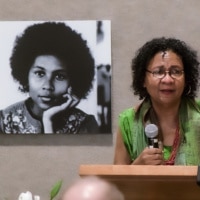Rituals associated with turning 21 tend toward alcohol and wild parties, but when Katie Trzepacz hit that milestone in August, she opted for attending a demonstration in downtown Murray, in support of removing the Confederate monument that has resided on the courthouse lawn since 1917.

Since she usually worked weekends, Katie had missed the regular round of Saturday protests to “Remove Robert” — General Robert E. Lee — until the weekend of her birthday. Starting on Friday, Aug. 14, the demonstration was a 24-hour event, sponsored by Sunrise Movement Murray and Murray State Democrats and timed to coincide with the kick-off of fall semester at the university.
Katie joined the group for the last half on Saturday. Angie Trzepacz, Katie’s mother, came along. She, too, supported the removal of the monument but hung back from the crowd while Katie joined the group standing closer to the memorial, most of them young women. One familiar face was Linda Arakelyan. In middle school, Katie and Linda played on the same recreation league soccer team, and both were alums of Murray High School.
Linda was known for athletic ability and AP classes. “She was pretty quiet,” Katie recalled, “but she was one of the people who listened.”
Emily Evans was there too. Although she supported moving the memorial for some time, this was her first time attending. Describing herself as low key and introverted, she admitted, “I like to stay in the background, but I didn’t want to oppose the statue and then do nothing.”
Although there had been some threatening behavior toward the protesters Friday night, the atmosphere on Saturday was mostly relaxed and friendly. Demonstrators made signs for themselves and others who wanted them. Katie remembers two she made. One said, “Move the Monument,” and the other claimed, “There’s no place for hate in Murray, Ky.”
Emily’s was short and to-the-point: “Remove Robert.”
With permission from local law enforcement, the sidewalk along Main Street by the courthouse had been festooned with artwork and slogans using colored chalk. “Black Lives Matter” was one inscription. Another was a reminder to say the names of people of color who had been killed unjustly, like Breonna Taylor and Tamir Rice.
Photographer and community member Christine Lindner was there to show her support for moving the monument, and to document the events of the day. The chalk sentiments caught her eye. “I was touched by the statements,” she said.
Some bystanders, however, were offended because chalk dust was being tracked from the sidewalk to the bricks honoring veterans, in the northwest corner of the square,
“People were saying things like, ‘Get out of my town,’” according to coordinator of the event, Kristen Farley. No matter that she was born and raised in Murray and her family has roots in Calloway County reaching back generations. Her grandad was one of the veterans commemorated with his name on a brick too, but because of her support for moving the monument, she was an outsider.
No one could report exactly how another local, William “Sandy” Forrest, knew where to find a water hose on the courthouse property and gain access to use it, but what happened next is the crux of this story. He began spraying the chalk to obliterate it from the sidewalk. As he got closer to the cluster of young women near the statue, Kristen remembered telling him, “We’re not going to let you spray them.”
Mr. Forrest, a member of Sons of Confederate Veterans, ignored their protests. As he sprayed the sidewalk, the women used their signs to protect the chalked inscriptions, most of them getting wet in the process.
“We were not going to give up our First Amendment rights,” Christine Lindner explained.
Some confusion ensued, but Linda Arakelyan and a few others did not back down. “Linda was targeted,” is the way Kristen remembers it. “She looked fearless.”
Angie Trzepacz watched as her daughter and a few others moved forward to capture the events on video. “It happened very quickly,” she said.
When Katie held up her sign to block the water from the hose, her mother remembers how the red ink from Katie’s sign ran down her legs. “It was horrifying,” her mother recalled.
She knew it was not blood, but the images of the water, of young women being hosed down by an angry man, and memories of vintage photos from the Civil Rights movement, heightened the impact of the moment.
“I was impressed that Linda was brave enough, and young enough, to feel invincible,” Dr. Trzepacz remarked.
At one point during the fray, Linda Arakelyan tripped. “You got me in the eyes,” she yelled, as the barrage of water continued.
Someone called the police and things calmed down, but that is not the end of the story. On Sept. 15, Arakelyan was indicted on a misdemeanor offense when a Calloway County grand jury returned a true bill of indictment against her for a Class A misdemeanor by direct omission, according to an account printed in the Murray Ledger & Times.
Ms. Arakelyan’s offense was Falsely Reporting an Incident because she reported that Forrest had slapped her hand, supposedly knowing it was false. She pled not guilty, and a series of delays associated with COVID-19 restrictions have kept the case from the courts until later this spring.
In the meantime, Katie Trzepacz still remembers how impressed she was by Linda’s passion. “I’m glad I got involved. We didn’t do anything wrong,” she insisted, “and we will keep at it.”
Emily Evans admitted, “I had a more idealized view of Murray before this. It put a huge damper on my opinion of the place.”
“It’s a metaphor,” Kristen Farley declared, “a white man spraying Black people’s names.”
The demonstrations continue every Saturday morning from 10 to 11 a.m. Those who support moving the monument stand on one side, and those against it, on the other side of Mr. Lee. There is some dialog between the two groups, and drivers honk their horns as they pass. Occasionally someone shows a weapon or shouts profanity or a racial slur.
One of the “Remove Robert” contingent reported being disheartened by being “flipped off” by a passerby she goes to church with.
“When his wife saw what he was doing,” the young woman said, “she slapped his hand.”
“The police listened to us,” Christine Lindner said about the events of Aug. 15, “but the prosecutor did not. My concern is that when a woman goes to authority figures about abuse or violence, they will not be listened to; they will be prosecuted.
“I know how to advocate for myself,” she declared, but she fears the message to young women. “They learn when women say ‘No,’ they aren’t listened to.”
WKMS coverage of these events is online at https://www.wkms.org/.
Constance Alexander is a columnist, award-winning poet and playwright, and President of INTEXCommunications in Murray. She is a board member for Hoptown Chronicle.





